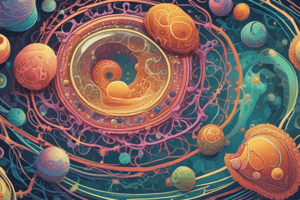Podcast
Questions and Answers
What structure in the nucleus is responsible for the formation of ribosomes?
What structure in the nucleus is responsible for the formation of ribosomes?
- Peroxisome
- Nuclear envelope
- Nucleolus (correct)
- Chromatin
Which component of the cytoskeleton is primarily involved in maintaining cell shape and forming the mitotic spindle?
Which component of the cytoskeleton is primarily involved in maintaining cell shape and forming the mitotic spindle?
- Intermediate filaments
- Microfilaments
- Centrosome
- Microtubules (correct)
What is the main function of the rough endoplasmic reticulum?
What is the main function of the rough endoplasmic reticulum?
- Lipid synthesis
- Synthesis of secretory and membrane proteins (correct)
- Ribosome formation
- Modification of proteins
Which organelle is known for digesting food and waste materials within the cell?
Which organelle is known for digesting food and waste materials within the cell?
What process occurs in mitochondria?
What process occurs in mitochondria?
What is the primary role of the smooth endoplasmic reticulum?
What is the primary role of the smooth endoplasmic reticulum?
Which component of the cytoplasm is primarily responsible for cellular movement?
Which component of the cytoplasm is primarily responsible for cellular movement?
What is the main function of the Golgi apparatus?
What is the main function of the Golgi apparatus?
Which organelle is NOT involved in the synthesis or modification of proteins?
Which organelle is NOT involved in the synthesis or modification of proteins?
In which structure does the nuclear envelope primarily function?
In which structure does the nuclear envelope primarily function?
Flashcards are hidden until you start studying
Study Notes
Nucleus
- Nuclear envelope consists of a double membrane that encloses the nucleus, featuring protein-lined pores that facilitate selective transport of molecules.
- Chromatin is composed of DNA intertwined with histone proteins, playing a critical role in packaging and regulating gene expression.
- The nucleolus is a dense structure within the nucleus, where ribosomal RNA (rRNA) is synthesized and ribosomal subunits are assembled.
- Peroxisomes are organelles responsible for metabolizing fatty acids and detoxifying harmful substances, containing enzymes for hydrogen peroxide breakdown.
Endoplasmic Reticulum
- Rough Endoplasmic Reticulum (RER) is studded with ribosomes, crucial for synthesizing secretory proteins and integrating membrane proteins.
- Smooth Endoplasmic Reticulum (SER) lacks ribosomes and is involved in lipid synthesis, hormone production, and detoxification processes in the cell.
Cytoplasm
- The cytoskeleton provides structural support and shape to the cell, composed of various filament types.
- Microtubules are critical for forming the mitotic spindle during cell division and maintaining overall cell shape.
- The centrosome serves as the primary microtubule-organizing center, playing a pivotal role in cell division.
- Intermediate filaments are durable proteins that maintain cell integrity and anchor organelles in place.
- Microfilaments, made of actin proteins, contribute to cellular movement and the formation of the cell cortex.
Other Organelles
- The plasma membrane serves as a selective barrier, regulating the entry and exit of substances in and out of the cell.
- Lysosomes are membrane-bound organelles that contain digestive enzymes to break down macromolecules, old cell parts, and microorganisms.
- The Golgi apparatus modifies, sorts, and packages proteins for secretion or delivery to other organelles.
- Vacuoles are storage organelles that can hold nutrients, waste products, or contribute to maintaining turgor pressure in plant cells.
- Mitochondria are known as the powerhouses of the cell, generating adenosine triphosphate (ATP) through cellular respiration to provide energy for cellular activities.
Nucleus
- Nuclear envelope consists of a double membrane that encloses the nucleus, featuring protein-lined pores that facilitate selective transport of molecules.
- Chromatin is composed of DNA intertwined with histone proteins, playing a critical role in packaging and regulating gene expression.
- The nucleolus is a dense structure within the nucleus, where ribosomal RNA (rRNA) is synthesized and ribosomal subunits are assembled.
- Peroxisomes are organelles responsible for metabolizing fatty acids and detoxifying harmful substances, containing enzymes for hydrogen peroxide breakdown.
Endoplasmic Reticulum
- Rough Endoplasmic Reticulum (RER) is studded with ribosomes, crucial for synthesizing secretory proteins and integrating membrane proteins.
- Smooth Endoplasmic Reticulum (SER) lacks ribosomes and is involved in lipid synthesis, hormone production, and detoxification processes in the cell.
Cytoplasm
- The cytoskeleton provides structural support and shape to the cell, composed of various filament types.
- Microtubules are critical for forming the mitotic spindle during cell division and maintaining overall cell shape.
- The centrosome serves as the primary microtubule-organizing center, playing a pivotal role in cell division.
- Intermediate filaments are durable proteins that maintain cell integrity and anchor organelles in place.
- Microfilaments, made of actin proteins, contribute to cellular movement and the formation of the cell cortex.
Other Organelles
- The plasma membrane serves as a selective barrier, regulating the entry and exit of substances in and out of the cell.
- Lysosomes are membrane-bound organelles that contain digestive enzymes to break down macromolecules, old cell parts, and microorganisms.
- The Golgi apparatus modifies, sorts, and packages proteins for secretion or delivery to other organelles.
- Vacuoles are storage organelles that can hold nutrients, waste products, or contribute to maintaining turgor pressure in plant cells.
- Mitochondria are known as the powerhouses of the cell, generating adenosine triphosphate (ATP) through cellular respiration to provide energy for cellular activities.
Studying That Suits You
Use AI to generate personalized quizzes and flashcards to suit your learning preferences.




